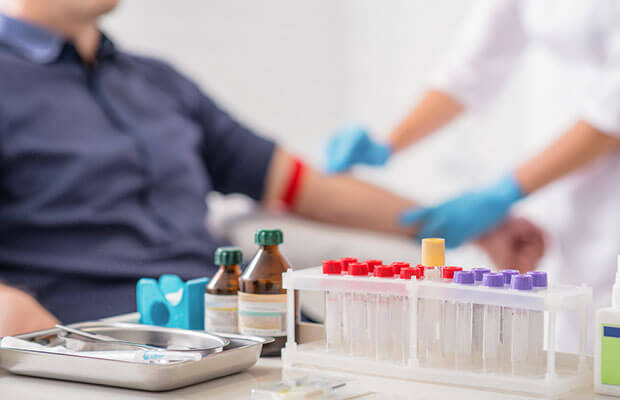The prothrombin time test can be altered for different reasons. Therefore, the doctor can order new tests to identify the correct cause and start treatment whenever there are alterations.
High prothrombin time
This result indicates that if a cut occurs, it will take longer for the blood to stop, with some more common causes being:
Use of anticoagulants;
Alteration of the intestinal flora;
Poorly balanced diet;
Liver diseases;
Vitamin K deficiency;
Clotting problems such as hemophilia;In addition to this, some medications such as antibiotics, corticosteroids and diuretics can also alter the exam’s value, so it is advisable to inform the doctor about all the medication you are using.
Low prothrombin time
When the prothrombin value is lower than average, it means that clotting occurs very quickly. So even though bleeding is rarer and usually stops quickly, there is a higher risk of clots forming that can cause a heart attack or stroke.
Some of the causes that can cause this alteration are:
Use of supplements with vitamin K;
Excessive consumption of foods with vitamin K such as spinach, broccoli or liver;
Use of estrogen tablets such as birth control pills.In these cases, it may be necessary to start using anticoagulants or heparin injections until the cause of the alteration is identified. After this, the doctor will recommend the most appropriate treatment.
What is a blood test?
A blood test is when a sample of blood is drawn for analysis in a laboratory. Doctors order blood tests to check things like glucose, hemoglobin, or white blood cells in the blood. This can help detect problems, such as an illness or medical condition. Sometimes blood tests can help them see how well an organ (such as the liver or kidneys) works.
What is prothrombin time?
The prothrombin time (PT) test measures the time it takes for a clot to form in a blood sample. Clotting ability is essential to prevent excessive bleeding. There are some proteins (called clotting factors) that are essential for the blood to clot well. If there is not enough clotting factor, or if one of them is not working the way it should, it may take longer than usual for the clot to form.
Why is this test done?
PT is done to evaluate bleeding problems. Your child may have this test if he has had a lot of bruising or bleeding if he has a medical condition that can cause clotting problems, if he is going to be operated on, or if he is going to have a procedure that may cause bleeding. . The PT test is also done to determine the level of clotting in children who are taking blood-thinning medications.
How should we prepare for the test?
Your child can eat and normally drink unless another test is also required at the same time that he requires prior fasting. Tell your child’s doctor about any medications because some medications can influence the test results.
Wearing a short-sleeved shirt on the day of the test can make things easier for your child; They can also carry a toy or book to distract them.
How is the test done?
In most blood tests, a sample of blood is drawn from a vein. For this purpose, a health professional:
Clean the skin places a rubber band (tourniquet) around the area to make the veins swell with blood.
inserts a needle into a vein (usually in the arm, either on the inside of the elbow or on the back of the hand)
Insert the blood sample into a vial or syringe.
remove the gum and remove the needle from the veinIn infants, blood can be drawn from a heel stick. After cleaning the area, the healthcare professional will make a small puncture in the baby’s heel with a tiny needle (or lancet) to collect a small blood sample.
Taking a blood sample only causes temporary discomfort, and all you feel is a brief pinprick.
Can I be with my child during the test?
Parents can often stay with their children during blood tests. Try to get your child to relax and tell him to stay very still because tight muscles can make it difficult to draw blood. Your child may want to look away from the needle when inserted into the skin and when the blood is drawn. Please help your child relax by taking deep breaths or singing his favourite song.
Rida.
How long is the test?
Most blood tests only take a few minutes. Sometimes it can be complicated to find a vein, so your healthcare professional may have to try it more than once.
What happens after the test?
Your healthcare professional will remove the rubber band and needle and then cover the area with a cotton ball or plaster to stop the bleeding. After removal, a small bruise may appear, which should disappear in a few days.
When will the results be ready?
Blood samples are processed using a machine, and the results can take anywhere from a few hours to a day to be ready. If the test results indicate a possible problem, the doctor will order other tests to find out what the problem is and how to treat it.
Is the prothrombin time test associated with any risks?
The prothrombin time test is considered a safe procedure and is associated with minimal risks. Some children get dizzy or faint when blood is drawn. A few children and teenagers are terrified of needles. If your child is anxious, talk to his doctor before testing about making the procedure easier.
It is common for a small bruise and mild muscle pain to appear in the puncture area, which may last a few days. Seek medical help if your child’s discomfort or discomfort gets worse or lasts longer.
If you have any questions about the prothrombin time test, speak with your child’s doctor or the professional who will be doing the blood draw.

